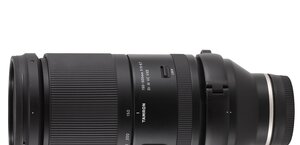Panasonic Leica DG Macro-Elmarit 45 mm f/2.8 ASPH. M.O.I.S.
3. Build quality and image stabilization
Out of necessity we decided to compare the tested lens to other macro instruments designed for sensor smaller than full frame. The comparison is presented in the following chart. It would be difficult to draw any constructive conclusions by looking at it, though – the lenses differ greatly when it comes to their properties. Some feature optical stabilization, others an ultrasonic autofocus motor; apart from that they also differ in focal lengths and apertures. Leica is the smallest and physically the lightest device here but also it has the shortest focal length and, along with the Canon, the slowest aperture. It boasts optical stabilization for a change – like no other competitor, presented in this chart.
In the photo below you can see the tested lens positioned between two „pancakes” : the Panasonic 2.5/14 and the Olympus 2.8/25.
Please Support UsIf you enjoy our reviews and articles, and you want us to continue our work please, support our website by donating through PayPal. The funds are going to be used for paying our editorial team, renting servers, and equipping our testing studio; only that way we will be able to continue providing you interesting content for free. |
- - - - - - - - - - - - - - - - - - - - - - - - - - - - - - - - - - - - - - - - - - - - - - - -
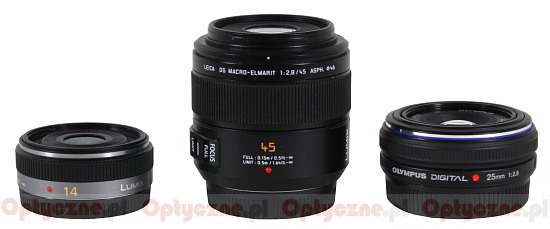 |
How does the build quality and the solidity of the barrel look like? In short- splendid! The lens starts with a metal bayonet mount which surrounds contacts and a rear immobile element. The element is 18 mm in diameter and so it is smaller than the diameter of the 4/3 sensor which amounts to less than 22 mm. What influence it has on the image quality we are going to find out in the next chapter.
 |
Already on the casing of the lens we find the first part of its barrel and there, on one side you can find the focal length marking, written with a typeface characteristic for Leica. A bit lower we get the description of the lens’s distance range in FULL and LIMIT modes. On the left there’s a row of switches. The first one is used to limit the working range of the focusing mechanism, the second one allows us to switch on and off the optical stabilization. On the other side of the lens, looking from the upper part of the body, we can also find a piece of information that the lens was produced in Japan and it is designed to work with the 4/3 Micro system.
 |
The next part of the casing is occupied by a ribbed and rubberized manual focus ring. It is 19 mm wide and its work is beyond reproach – it moves smoothly, it is well-damped and allows very precise settings.
Moving on we meet a narrow, smooth ring on which there is the name and parameters of the lens. Even further the diameter of the tube narrows. The narrower part of the casing has a hood mount outside and a non-rotating filter thread 46 mm in diameter inside. The lens ends with an immobile front element which is 19 mm in diameter.
When it comes to the inner construction we deal here with 14 elements positioned in 10 groups. One low-dispersion ED glass element and one aspherical element were used too. The picture is complemented by an aperture with seven diaphragm blades which can be closed down to f/22. It’s worth reminding here that the focal length of the lens is shortened when we pass to minimum focus distances because of the sealed construction and the inner focusing system. What’s more the minimum focus distance, stated in the specifications as 15 cm, is measured, as usual, from the main plane of the lens. In reality we can photograph objects which are in the distance of about 7 cm from the front element.
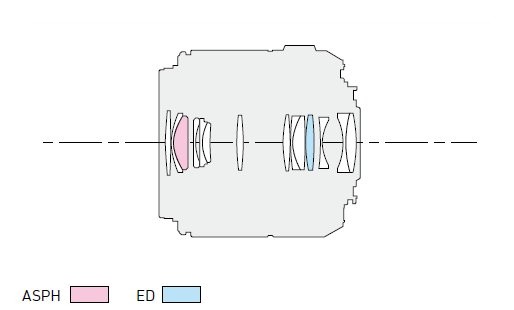 |
The buyer gets both caps, a lens hood and a soft case included in box.
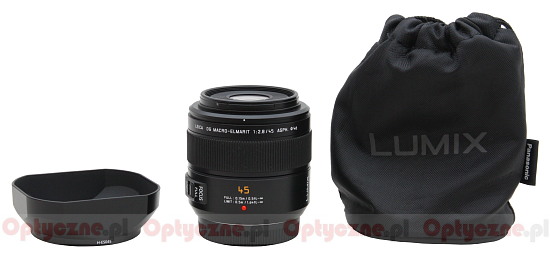 |
Stabilization
The stabilization test we conducted in our usual way. For every exposure time ranging from 1/100 to 1/5 of a second we took several dozen photos with the stabilization on and off. Then we determined the percentage of blurred photos and presented it as an exposure time function graph expressed in EV (with the zero point being the equivalent of 1/80 of a second). The said graph can be seem below.
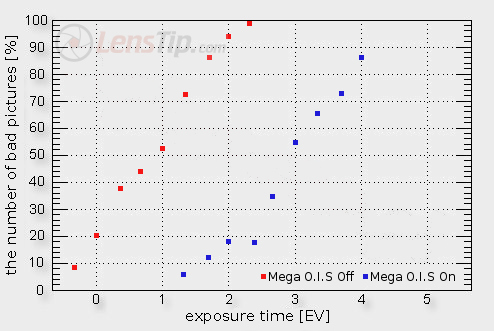
As you see the stabilization efficiency doesn’t bowl us over. When most of expensive and stabilized lenses produced by Canon, Nikon and Sigma are able to reach the level of 3 EV and the best of them - even the level of 4 EV, the result of the Panasonic, amounting to just about 2.3 EV, doesn’t look good at all. Especially that the 2-2.5 EV stabilization efficiency level is also achieved by the sensor’s stabilization, implemented in Micro 4/3 Olympus bodies.




